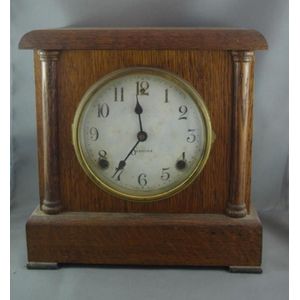Inlaid Sheraton Revival Bracket Clock by Benetfink & Co
Benetfink & Co., London, inlaid Sheraton Revival bracket clock, no key, has pendulum, approx 36 cm high, 27 cm wide, 17 cm deep
You must be a subscriber, and be logged in to view price and dealer details.
Subscribe Now to view actual auction price for this item
When you subscribe, you have the option of setting the currency in which to display prices to $Au, $US, $NZ or Stg.
This item has been sold, and the description, image and price are for reference purposes only.
- Pendulum - The pendulum was discovered around 1602 by Galileo Galilei, and was adopted for time keeping by the Dutch mathematician and natural philosopher, Christiaan Huygens, who excelled in astronomy, physics, and horology.
The pendulum comprises a metal rod usually of brass or steel with a metal disk, known as a bob, at the end. The movement of the pendulum is driven by weights or a spring, and as a pendulum swings in a regular arc, it was found accuracy could be controlled to within a few seconds a week.
Timekeeping can be adjusted by changing the height of the bob on the rod, making the pendulum either swing slower or faster.
The disadvantage of the pendulum was that changes in temperature also changed the length of the pendulum, interfering with the accuracy of the clock, and so in the 18th century two types of mercurial pendulums were invented which countered the movement in the steel rod.
The pendulum was the world's most accurate timekeeping technology until the invention of the quartz clock, regulated by a quartz crystal, in 1927. - Thomas Sheraton - Thomas Sheraton (1751-1806) was born in Stockton on Tees in the north of England. He was apprenticed to a local cabinetmaker and after working as a cabinetmaker, Sheraton moved to London about 1790. Although he described himself as a cabinet-maker, like Chippendale, no definite piece of furniture can be traced to him as maker. Nevertheless, he was immensely influential and in 1791-4 published his four volume book 'The Cabinet-Maker and Upholsterer's Drawing Book'. The books were used as source of design by the furniture-making trade , who often simplified or modified the designs to suit their own preferences. Sheraton furniture is marked by restraint and sophistication, elegance and discretion, though he also found time to invent fanciful combination furniture.
This item has been included into following indexes:
Visually similar items

Oak inlaid bracket clock, no key, has pendulum, approx 32 cm high, 24 cm wide, 13 cm deep
Sold by
in
for
You can display prices in $Au, $US, $NZ or Stg.

Regency Period English mahogany bracket clock by Crouch of Brixton c.1825 with brass inlay, original grills and handles to the sides (retail label of George Clark, Adelaide)
Sold by
in
for
You can display prices in $Au, $US, $NZ or Stg.

Sessions mantle clock with striking movement, in oak case, 24.5 cm wide, 25 cm high
Sold by
in
for
You can display prices in $Au, $US, $NZ or Stg.

A Victorian mahogany bracket clock with enamel dial
Sold by
in
for
You can display prices in $Au, $US, $NZ or Stg.
